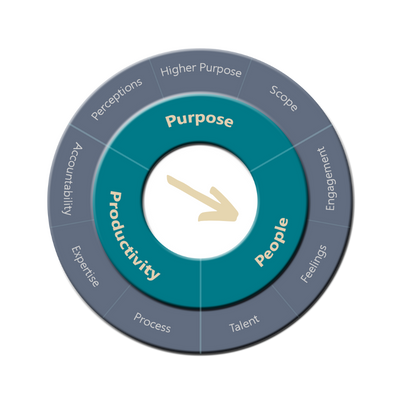This second instalment of a three-part series focuses on the “People” category, highlighting three key leadership elements: engagement, feelings, and talent.
Engagement: Leaders must connect team members to the organisation’s purpose, fostering personal commitment and motivation. Consistently reinforcing the “why” helps maintain alignment and enthusiasm.
Feelings: Creating a psychologically safe environment is crucial for innovation and growth. Leaders should promote a culture where failure is seen as an opportunity to learn, encouraging resilience and risk-taking while maintaining accountability.
Talent: Attracting and developing the right talent is not just a goal; it’s a necessity. Leaders must ensure their teams are diverse in thought, aligned with the organisation’s purpose, and capable of driving success. Tough decisions may be necessary to maintain a high-performance culture, but the benefits of a diverse and capable team are worth it.
The article also provides critical questions for leaders to assess and enhance their approach to engaging, supporting, and developing their teams. The series will conclude with a focus on mastering productivity, emphasising effective plan execution.

In this second part of my three-part miniseries, we’ll explore the category of people, which follows hot on the heels of purpose, which we explored in part one.
The people category is comprised of three elements: engagement, feelings and talent. Your role as a leader is to create a psychologically safe space where people can thrive and deliver. People perform at their best when connected to their work and when they understand the impact it will have. They also need the space and opportunity to learn, grow and develop, knowing their boss has their back.

Let’s take a closer look at the three elements of the people category.
Engagement
Skilled leaders bridge the gap between individuals and the higher purpose. They help team members understand the significance of the goal on a personal level, fostering a sense of purpose and passion within each person.
I work with many leaders on their purpose. They put time and effort into crafting an inspiring, compelling, and engaging message. Enthused by their work, they share it and get their troops fired up, only to let it die on the vine.
The purpose (the “why”) is a leader’s most potent engagement tool; it helps you find the right people for the journey. Purpose is a drum that you need to bang repeatedly, constantly reminding people why we all do what we do.

Feelings
This is far from the soft side of leadership. Leaders are custodians of organisational culture, responsible for cultivating an environment where people can flourish, learn and push boundaries. To do this, you must provide a psychologically safe space where individuals can confidently pursue growth and innovation, knowing their boss has their back.
I have heard leaders openly say, “It’s okay to fail,” only to blow up when things go wrong. In her book Dare to Lead, Brené Brown likens this to sticking someone on a plane and expecting them to skydive without first teaching them how to land.
As a leader, you must build a win-or-learn culture, harnessing failure as an opportunity to grow. This does not mean ignoring conduct and capability issues; people still need managing. But encouraging them to take a chance means people will innovate and do the right thing when it matters most.
Talent
Leaders are blessed (or cursed) with the relentless pursuit of finding and retaining the right people aligned with the higher purpose. Make sure you surround yourself with talented individuals connected to the purpose, and nurture and develop your team members, ensuring that their skills match the organisation’s demands. You must also make tough decisions to dismiss those who are not fully committed to the journey.
Three common pieces of advice for leaders are to surround yourself with different thinkers, clearly define high performance and intervene when people aren’t cutting it.

I have coached several leaders who have built a team of people like themselves. We like people who see the world as we do. But how do you know what your people really think? Find people who see the world differently from you; encourage, if not demand, that they challenge your perspective. People whose careers are in their boss’s hands will often play it safe when authority bias is at play.
I’ve seen leaders so focused on a top performer that they overlook their poor behaviours while picking up on other team members’ behaviours. This inconsistency creates a two-tier system that leads to a downward trend in overall performance, and people leave.
In one example, I worked with a leader who held their top performer accountable, only for them to exit. They were terrified their numbers would decline. However, the team responded positively; the overall team performance went up over time as people recognised that how we do the work is as important as the results. The team is now aligned and committed to the cause; of course, they still have challenges to overcome, but they work together.

Sadly, I have had to dismiss team members several times, but only after allowing them time to improve with coaching and support. In one case, it became apparent that their heart wasn’t in it, so it needed addressing.
I had a challenging conversation with them, after which they thanked me. They were desperately unhappy at work. My primary learning was to intervene early; we both could have avoided the pain of a drawn-out process.
This next section lays out a set of questions to help you stress-test the people category. It will help you define, check and balance so you can get the right people on the team, develop capability and engage people to get the best out of them. It will also help you understand how teams interact and how to encourage and manage healthy conflict while creating an environment where people want and feel able to give their best.
Questions to Ask
If you want to create an environment for people to flourish and a team people want to join, ask these questions.
Engagement
- How might we connect people to the purpose?
- How might we motivate people and keep them going?
- What support structures might we need?
- How might we help people learn and grow?
- How might we measure engagement?
Feelings
- How might we remove the fear of conflict?
- How might we build resilience in our people?
- How might we promote change as an opportunity?
- What are we doing to create a psychologically safe environment?
- How might we encourage meaning and purpose?
Talent
- How might we attract the best people to work with us?
- What do we need in our talent base—now and in the future?
- What could we do to improve capability and develop capacity?
- How might we create a learning culture in our teams?
- How do we ensure that we nurture and retain talent—and move people on (or out)?
- How do we identify talent?
Look out for the final part of this three-part miniseries where I’ll unpack the third area leaders must master for success: productivity.
Great leaders recognise that creating the right environment for their people to flourish with a compelling purpose is all well and good, but they still need to execute the plan and get it done.
This article first appeared on Forbes.com on 1st September 2023
Ricky has been a regular contributor to the Forbes Councils since 2023, where he shares his perspectives on all things leadership, change, culture and productivity, all with Thinking Focus’ unique perspective on metacognition, or as we prefer to say, thinking about thinking.






